The Sacred Images Project, 2025 Season Two - maps and links to all the things
Start here: what we've covered and where we're going

Welcome to the pinned post: a map
My visit last year to the Cripta San Magno, an incredible trove of 11th century frescos about an hour from Rome. Made possible by you, paid subscribers. One of the biggest tasks for us is to reveal works of surpassing wonderfulness that hardly anyone outside Italy has heard of.
Something that has been going on consistently since we started all this, back in the summer of 2023, has been the steady increase in new subscribers, both paid and free. Last I counted, it’s been an average of 10-15 free subscribers per day, with some days as high as 30! Which tells me there’s a lot of interest in what we’re trying to do: bringing back a deeper knowledge and understanding of the ancient traditions and history of Christian sacred art, and how they relate directly to spiritual realities of our lives.
Now that we’re entering into the second quarter of our Big Editorial Plan for 2025, and spring is springing everywhere, it’s time for a recap and a bit of a map of where we’ve been and where we’re going next and why. So, a warm welcome if you’re new here. This is the pinned post for our current season, and it’s where you can get your bearings.

The Sacred Images Project is an ongoing exploration of Christian history, theology, and culture through the lens of the first 1200 years of sacred art. Each quarter, we trace a thematic and chronological arc, walking through the centuries, tracing the meaning of it all in architecture and frescos, mosaics, manuscripts and monasteries. Consider this our version of the “Previously on…” recap episode, not a detour but a map, with plenty of links.
From Catacombs to Empires: Where We’ve Been and Where We’re Going
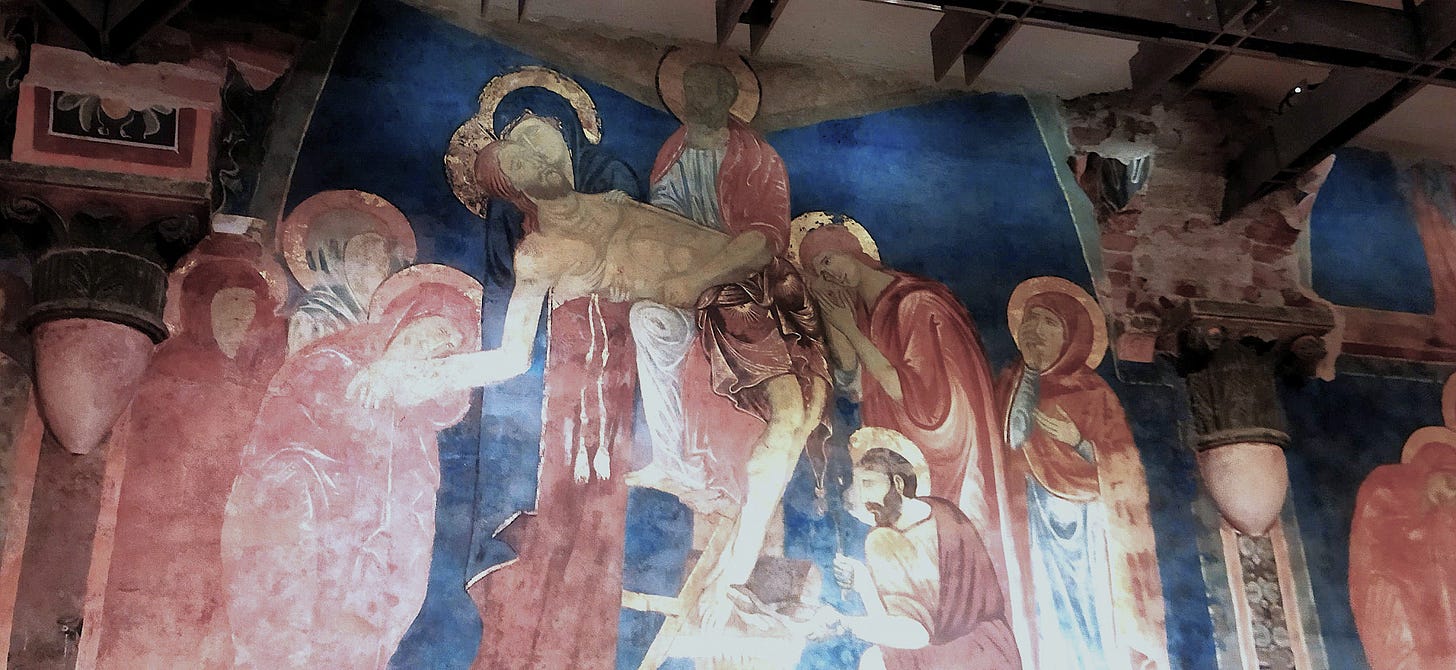
In the beginning of 2025, we launched into the organised Big Editorial Plan, starting at the beginning, the roots of Christianity’s visual and theological imagination in hidden language and symbols, formed in the shadows of persecution, shaped by divine mysteries and expressed through sacred symbols. This project, which began as a study in sacred art, has become something more: a chronicle and deep exploration of Christian history and visual, liturgical theology, told through the language of images.
We began in the Roman catacombs, where Christian burial sites became the first galleries of faith, full of symbols, prayers, and the quiet testimony of hope. From there, we walked through the solemn mystery of early liturgies held in secret and entered into the intimate architecture of house churches, spaces where form and function converged to express divine presence. We explored the transition to public worship after Constantine, saw the triumphal mosaics of Roman basilicas, and began to understand sacred space not merely as shelter but as theology in stone and glass.
We visited the incredible golden mosaics of Ravenna’s 5th century, and the earliest foundation of Venice, the island sanctuary of Torcello where Roman citizens fled the mainland ahead of Atilla the Hun in the 5th century. We paused in the twilight of the so-called Dark Ages of Northwestern Europe, and stood in awe before the intricate gold and enamel patterns of the Sutton Hoo hoard.
And we ended, three months later, in the blazing heat of the Egyptian desert, where monks carved out sanctuaries in stone and forged a visual theology of silence, stillness, and flame.
Greatest hits from the first season
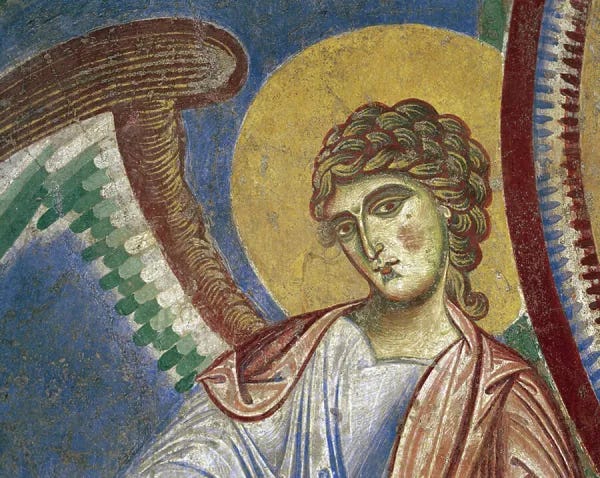
With most good shows, the first season can be a bit uneven; the showrunners finding their footing, learning the ropes, but there are always some real bangers that set the tone for the whole thing. In the earliest days, we looked at the basic problems of Christian sacred art: how to depict the invisible triune God and spiritual realities; why it can’t just be left up to individual taste and preferences of either the artist or the viewer; and why Naturalism and Renaissance Humanism was the beginning of the end for western sacred art, a radical departure from the ancient tradition.
So, here is a list of posts from the early days, that set our agenda and tone, and general approach, topics and themes:
What happened to art in the 20th century? - how did ugliness become the standard?
Who killed art and why?: Dadaism: “the sickest, most paralyzing and most destructive thing that has ever originated from the brain of man”
The Man Who Saved Art: how the classical drawing tradition survived the 20th century Purge
Woe to him who calls ugliness beauty: “Nothing can be beautiful which is not true.”
How Renaissance Humanism and Naturalism killed western sacred art
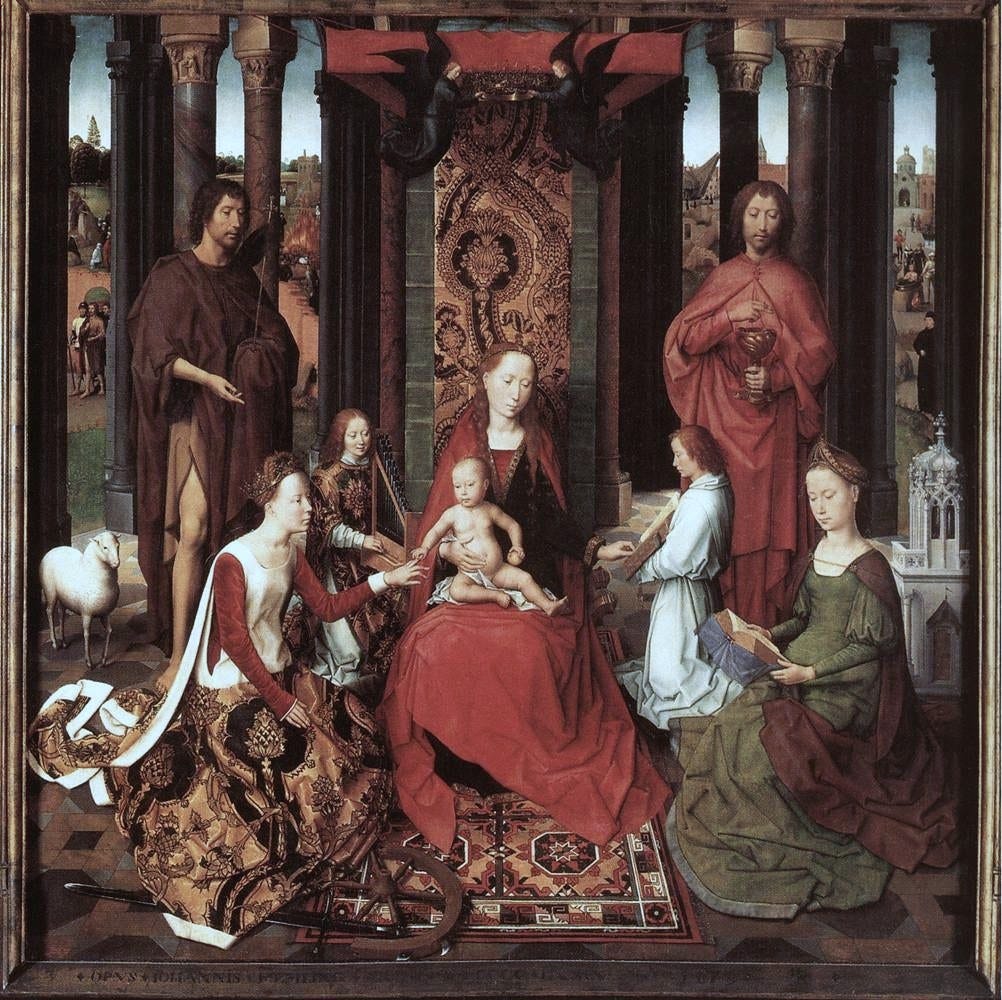
Lies the Renaissance told you, P1: The reason you probably don't like Byzantine Icons
Lies the Renaissance told you Pt 2: “Putti” vs. the invisible powers of heaven
No, The Renaissance, Man is not “the measure of all things,” sit down: The philosophical confidence trick we still suffer from
Northern Gothic Devotion vs. Renaissance Humanism: Part One: Let's look at Gothic art
Rupnik, the corruption of modern visual culture and why AI-generated images can’t be art
Marko Rupnik and iconographic heresy: A new time for a lost ideal
What Marko Rupnik’s art tells us about the modern Catholic Church: The worship of chaos
The eyes of Marko Rupnik: black soulless holes? The eyes are the “alpha and omega” of (real) Byzantine art
Corita Kent: how the New Art helped the Catholic Sexual Revolution: The political and occult origins of the Rupnik Scandal
AI images: Whatever it is, it’s not “sacred art”: The "Robert Powell Problem" in iconography explained
Mary, Queen of Heaven or Tolkien's Varda, queen of the Valar?: A conversation about AI and sacred art
OK, what is "Art" anyway?: Agency, Craft, Techne and Telos
Deep Looking: prayer, spirituality and art
Deep Looking, drawing and the road to true prayer: How learning to draw what I saw taught me to pay more attention to God
Part I of the desert and the pursuit of holiness: The way forward is through the desert
Two realities embrace - nature and grace: A spiritual conference from our resident Benedictine mother superior
The full archive is available to paid (and partial, to free) subscribers here:
On to 2025: What we covered in Quarter 1
The Reboot: We began this year by wrapping up our long-running story on how western Christendom and the papacy hit absolute rock bottom, and how the new Ottonian emperors, and the foundation of the great abbey of Cluny, rescued it, what I think of as the ‘happy ending’ to the Saeculum Obscurum. Then we returned sharply and deliberately to the beginning. The blog reboot wasn’t just a fresh start but a full return to the foundations: to the first sacred spaces hidden in catacombs and secret “house churches”, the earliest images and formative theology of the Christian imagination.
The structure going forward is chronological, but it’s also thematic, liturgical, and visual. The first quarter was devoted to the early Church, from the 3rd to the end of the 6th century, roughly.
Byzantine Form and Meaning: We began the slow climb into Byzantine aesthetics with posts on the visual language of icons, Italo-Byzantine painting and mosaics, and the art of the newly founded Roman imperial capital at Constantinople.
The Western Edge of the World: We also peeked westward at the lost glories of Anglo-Saxon culture, buried treasure and the art of the so-called Dark Ages.
Our new feature, “Off-Topic” posts - like What are oaths and why do we still do them in officially godless Modernia? and The redemption of Mr. Collins: sympathy for an unloved man; are still thematically connected. How Modernity forgets the symbolic, the sacred, the beautiful, and why that matters.
The Desert Fathers and the Monastic Vision: We closed the first quarter of the Plan in Egypt, with the foundation of the first monastic settlements in Egypt, and early monastic iconography, spiritual theology, and an exploration on the true meaning of “venerating” an icon: a creation of intimate connection with the person or scene depicted.
What’s Coming in Quarter 2
Mosaic decorations of the Mausoleum of Galla Placidia, Ravenna
If the first quarter was about laying foundations, both in history and in visual language, this next season will be about watching those foundations grow, diversify, and take root across a wider and wilder Christian world. Between roughly the 6th and 9th centuries, we’ll follow the expansion, refinement, and sometimes chaotic evolution of sacred art and architecture as Christianity spread outward from the Byzantine Roman Empire’s shadow into new lands and new cultures.
This quarter’s arc will move through five broad but interconnected zones of artistic and theological development:
All About Byzantine
We’ll deepen our exploration of the iconographic tradition born in the East: mosaics, wall paintings, domes, and the visual theology that crystallised in the imperial capital of Constantinople. We’ll also look at the iconoclastic controversies that shook the Empire and shaped the very definition of sacred art for centuries to come.
Merovingians to Carolingians
From post-Roman Gaul to Charlemagne’s revival of empire in the West, and his gathering of all western Christian peoples in his imperial school at Aachen. We’ll trace how sacred art became a political and cultural tool for unifying diverse peoples. Expect illuminated manuscripts, royal chapels, and the earliest stirrings of what would develop into the Romanesque.
Ireland, Britain, and the Vikings (7th–9th c.)
We’ll travel to the misty isles of the north and study the fusion of Celtic, Anglo-Saxon, and early Christian motifs. Think Lindisfarne, Iona, and Norse-tinged conversions, intricate designs, interlacing forms, and missionary saints with portable altars and iconographic imagination.
The Edges of Christendom: Anatolia, Armenia, Georgia, Croatia, Ethiopia, India, and Asia
Christianity didn’t stop at the borders of Rome or Byzantium. We will investigate the vibrant sacred art and theological traditions that flourished on the margins of the old empires: from the cave churches of Anatolia and the ancient stone sanctuaries of Armenia and Georgia, to the Latin-Byzantine hybrids of Romania and Croatia, the illuminated manuscripts, wall paintings and church forests of Ethiopia, and the enduring Christian communities of India and Asia. These were not fringe outposts, but fully-formed expressions of the Christian imagination, diverse, beautiful, and rooted in apostolic faith.
Russia has entered the Christianity Chat
Just as the Carolingian world was forging a new Christian empire in the West, and Byzantium was defining the image in the East, a new player appeared on the northern frontier. In the 9th and 10th centuries, the Slavic world, especially the emerging Rus,’ began to convert, carrying the Byzantine tradition into fresh soil. We will explore the visual and spiritual legacy of that moment, from the baptism of Prince Vladimir to the shimmering domes of Kievan Rus.
The Benedictine Empire
We’ll be returning to the Latin West, where monasticism became a machine for civilisation, evangelisation of pagan European peoples, and a bulwark against heresy. From the many-layered development of the Rule of St. Benedict to the establishment of the great abbeys of Cluny, Farfa and Monte Cassino; these held vast land and industrial assets and became immensely powerful, miniature empires-within-empires. We’ll see how monasteries preserved, transmitted and created sacred art, turning spiritual labour into cultural renewal.
Bigger plans going forward
Whether you’re just discovering this project or you’ve been following along since the beginning, welcome and thank you. I’m really serious when I say I wouldn’t be doing this if you weren’t coming along. I don’t come to this as an expert, by any means. But as a journalist, the one thing I learned was how to frame questions and find answers, and I always take the position of being an investigator, exploring and reporting back about the incredible things I’m finding.
The Sacred Images Project is part of a larger effort to recover and make accessible the lost riches of Christian sacred art, history, and tradition. There are several ways you can stay connected, explore more deeply, and support this work as it grows, whether you’re here to read, study, teach, or simply to reawaken a sense of wonder.
We were able to visit Ravenna only for a few hours on the way home from Venice in February, so it was a desperately short visit, that did little more than make me want to turn around immediately and go back again.
This project is growing into something more.
Alongside the blog, we’re building the Ars Sacra Cultural Association, a formal non-profit society based in Italy that will serve as a platform for education, artistic revival and the preservation of Christian patrimony. A new, fully independent website is underway, with a redesigned archive, integrated membership benefits, and a curated shop offering prints, teaching tools, and devotional resources.
Coming soon: seasonal eBooks based on our quarterly explorations, micro-courses, short posts on classical monastic spirituality and a spotlights on the best contemporary sacred artists. The goal is to create a living ecosystem where traditional Christian sacred art is studied, supported, and shared.
How to Follow, Subscribe, and Support
Free and paid subscriptions:
Free subscribers receive one full post each week, typically the mid-week edition, designed to be informative, thoughtful, and accessible to anyone at every level of interest.
Paid subscribers get much more:
A weekly in-depth Monday essay, often featuring original photos, video, or downloadable high-resolution images
A PDF version of each paid post for offline reading, printing, or archiving
Access to the entire archive of essays, visual studies, and timelines
Regular extras: weekend “Off Topic” posts, spiritual reflections and end-of-season micro-courses/eBooks
Subscriptions help keep this project alive and growing, and support the ongoing effort to recover and share the Christian artistic tradition.
The Shop
Until the new website is up and running, with it’s better shop, you can browse printables and fine art prints inspired by the material covered here. Your purchases support the research and the tools needed to keep publishing high-quality posts every week.
Coming soon: Seasonal micro-courses designed to explore sacred art more deeply, perfect for homeschoolers, self-learners, or anyone who wants to see with “the eyes of the soul.”
Every subscription, comment, re-stack, share or print order helps build this community and makes it possible to keep digging into this rich and often neglected patrimony.
Thank you to everyone who has already subscribed, and welcome again to all newcomers. I hope you will grow with us.




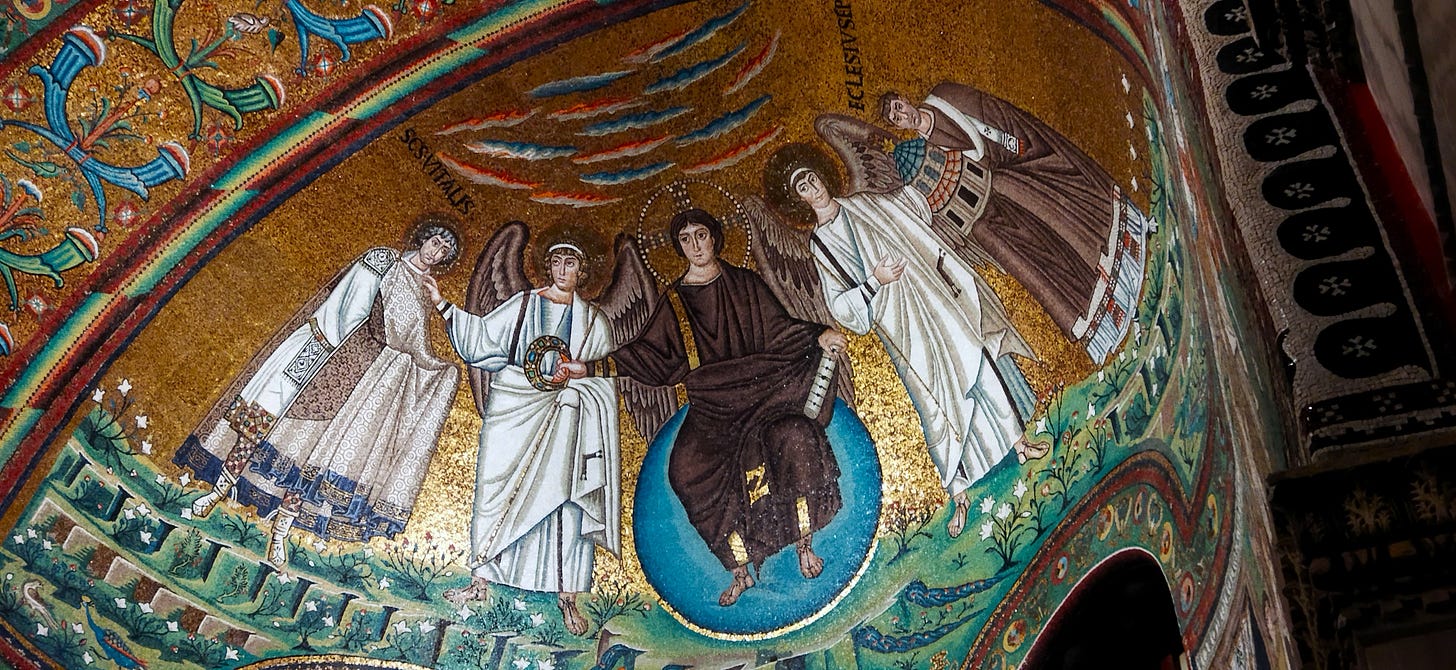

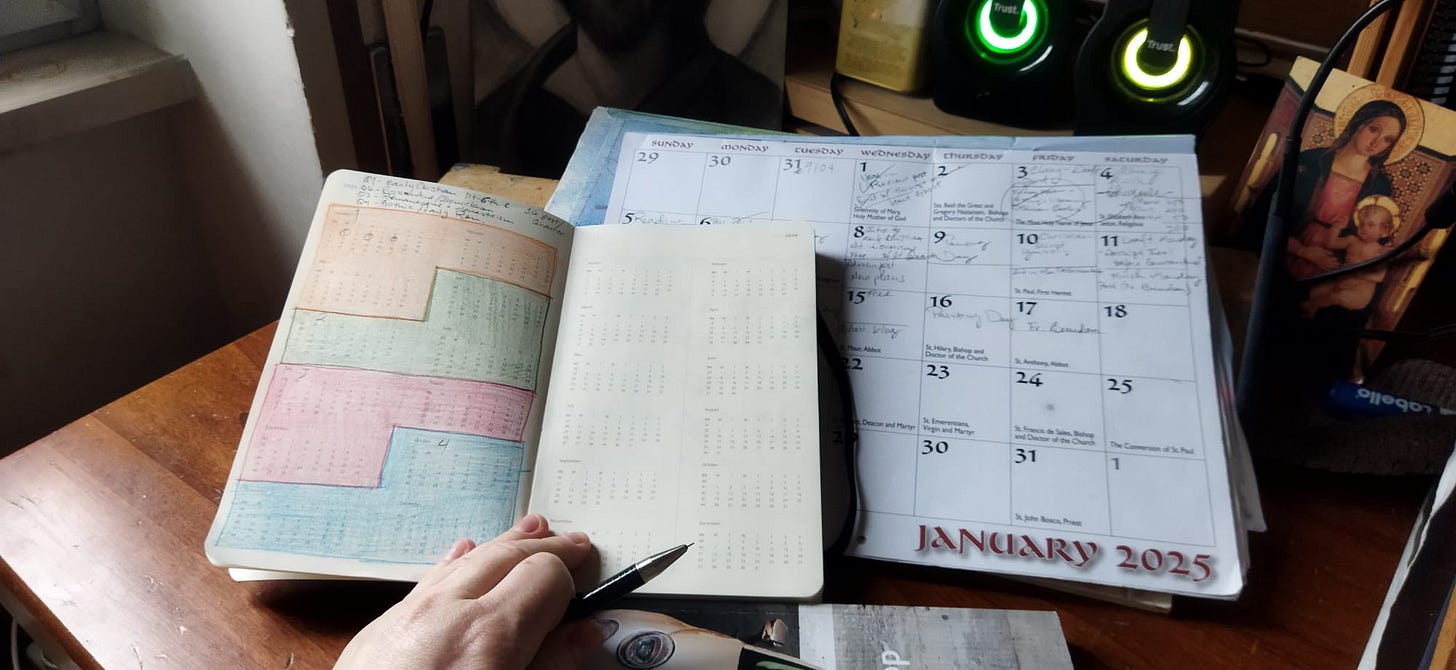


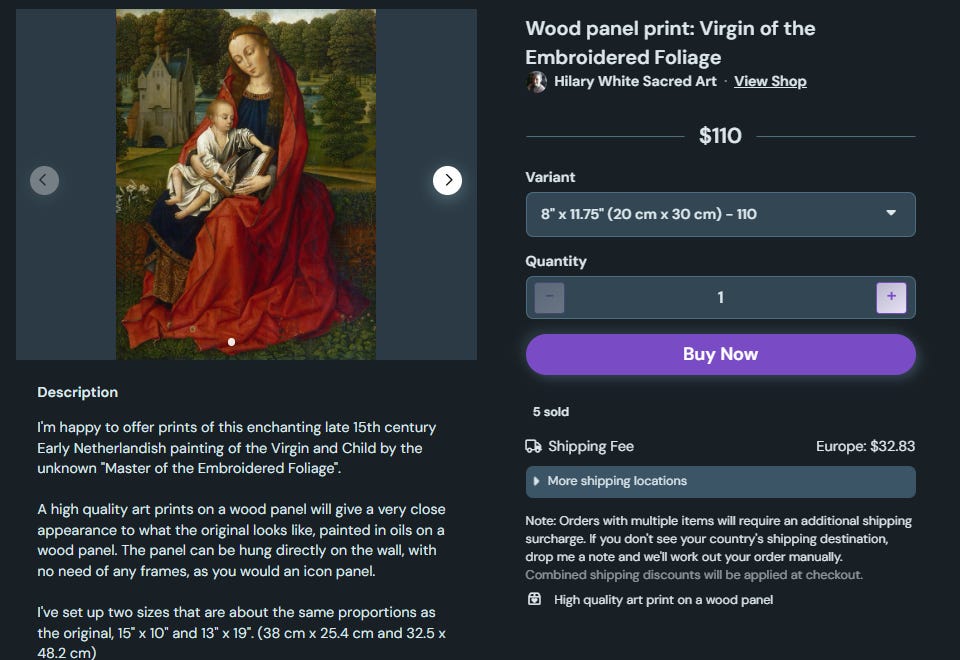
I like this one: Apse mosaic, San Vitale, Ravenna. 5th century. Photo by me.
They have some beautiful churches in Ukraine if you ever get a chance to go there. The Mariendom in Linz, Austria is amazing, and not many tourists. I think it is slightly than Stephansdom in Vienna.
Thank you sister. We all need to take a breath and gaze with wonder on these visual images of our tradition and faith, especially since so many young people were not raised hearing the bible stories from their youth. 😌 We really appreciate the research ⏳✍🏼 you put into the reports and helping us get a sense 📿🕯️of the where- when- who behind these expressions of our Common Heritage 🌐 and Sacred Faith. East West North South ~ the Kingdom is Vast and we never pray alone....🕊️🎶✨♥️☦️⛪⛲
.....one day at a time!